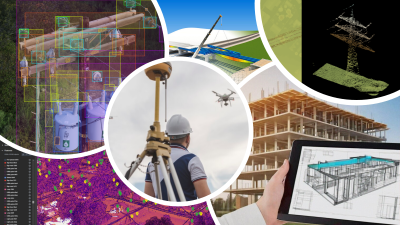Anyone who pays any attention to the news, particularly anything to do with the business world, knows that artificial intelligence is the talk of every industry. Every sector is looking for ways that AI, and generative AI in particular, can transform their work. The result has been massive investment in both the technology and the companies who form the backbone of this boom like NVIDIA, and there are plenty who believe we are in an “AI bubble” similar to the Dot Com bubble experienced in the late 1990s and early 2000s.
In the meantime, construction is one industry that is certainly buying into artificial intelligence and its benefits at the moment. After years of being so-called technical laggards, AEC technology is a booming business and investment is through the roof from both inside and outside the industry. The question, however, is whether or not this is the right move for those in this space. As always, the answer isn’t a perfectly black-and-white one, but rather it depends on context and who you ask.
All of these thoughts come out of a conversation Geo Week News recently had with Steve Cangiano, who serves as Chief Product Officer at CMiC, a company who has been providing software to construction firms for over three decades. In our conversation, we discussed CMiC’s own approach toward implementing generative AI into their solutions, some general industry trends, and a recent survey report the company put out about the industry’s transition toward technology.
As a baseline for the discussion, it’s worth noting that the artificial intelligence at the center of the conversation was strictly of the large language model variety. Cangiano noted that CMiC has leveraged other types of AI and machine learning for different products, but as generative AI is what is receiving the vast majority of buzz around all industries it made sense to center discussions around it.

To be clear, while there may be some over-hype around the power of LLMs within the construction industry, there are ways that companies can extract real value from these tools being implemented into their workflow. Something Cangiano mentioned is that, from the CMiC perspective, they try to provide real, tangible examples of how these tools can be implemented. Often, this technology is marketed at the highest level, simply exclaiming how much value it can provide without really providing any real examples.
One that Cangiano gives is to create a model that will alert an administrator if a change order is more than $5,000 or exceeds the gross profit margin of a given job. It’s not the most exciting example of how technology can transform a workflow, but it is the kind of example that appeals to professionals who are working with software day-to-day, and is indeed a real example from one of CMiC’s customers. According to Cangiano, this is what those professionals – particularly those one or two rungs below the C-Suite – want to hear.
“These are real tactical and practical examples of what can be done with [LLMs], and that seems to be resonating better than just kind of talking about LLMs changing everything without really getting into the details.”
Of course, one of the biggest questions any construction firm is going to ask about before diving into the AI pool is going to be around data security. This is true of any industry, but construction is extremely precious with their data, and for good reason. Contractors have massive amounts of sensitive information at any given moment, and they don’t want to open themselves up to anything nefarious happening with it. From CMiC’s perspective, Cangiano notes that they’ve gotten around this by partnering with OpenAI and using their enterprise license, allowing users to develop their own specific models with APIs while taking advantage of OpenAI’s security.
Regarding the aforementioned report, one of the most interesting tidbits was the fact that 70 percent of respondents within the construction industry believed that their company underspent on digital technologies. It seems unlikely that such a majority is underspending on technology, but rather would seem to reflect a fear of being painted as technological laggards once again. Particularly with AI, while it certainly makes sense to test out new tools and not leave anything on the table, in an industry like construction with such low margins a firm also opens itself up to risk if they are throwing money at solutions simply to not fall behind their perception of what their peers are doing.
“I think a lot of construction companies are going to struggle with [AI adoption] for a little bit. They’re going to throw AI at every problem that’s there, and it may not necessarily be the best thing that they could be doing. Of course you want to have a strategy and you want to test it. You want to experiment, you want to have the right partners. That’s all important. But I think a lot of construction companies – and any company – is putting a little bit of unnecessary pressure on themselves to use it everywhere, all the time, where there are very specific use cases where it’s extremely beneficial.”

Looking forward, at least in the relative near-term, Cangiano sees APIs being the backbone of how generative AI and LLMs will mostly benefit construction. Every firm will have their own uses, and being able to create these specific models using APIs with larger platforms will be hugely beneficial. He uses CMiC as an example, being a massive software platform with many individual features, all of which probably aren’t known by every user. He gives an example of a model where a user could type in what they want to do, and the LLM would be able to sift through all of the features and indicate where in the software that can happen.
The next couple of years are going to be hugely consequential to all industries, and construction is no exception. There’s little doubt that AI is going to stick around in some form, just as there was never any real doubt the internet would go away in the midst of the dot com bubble. The question is what it looks like when the dust settles, and who over-extended versus who didn’t invest enough. For an industry like construction who has already been bitten by not adopting technology quickly enough in other contexts, the pressure seems particularly high. There’s no easy answer, but it seems focusing on tangible benefits while ignoring the high-level, non-specific pitches is the best route.
“This technology is very difficult to translate into return on investment,” Cangiano said. “When you go buy a crane, you can tell down to the penny of billable hours on a crane or bulldozer what your ROI is for that piece of equipment. It’s a little more difficult with this technology.”





.jpg.small.400x400.jpg)

